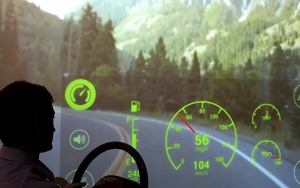CES: Google Cardboard Lets Quantum Demonstrate Eye-Tracking Car Technology
- by Laurie Sullivan @lauriesullivan, January 6, 2016
 Google's augmented reality glasses, Cardboard, are lending Quantum Interface a hand in demonstrating eye-tracking technology for automobiles at the Consumer Electronics Show. The
algorithms, similar to the technology used in eye tracking for online advertising, uses motion to detect natural body and eye movements to predict the driver’s next move.
Google's augmented reality glasses, Cardboard, are lending Quantum Interface a hand in demonstrating eye-tracking technology for automobiles at the Consumer Electronics Show. The
algorithms, similar to the technology used in eye tracking for online advertising, uses motion to detect natural body and eye movements to predict the driver’s next move.
The demo combines Quantum’s motion control user interface with eye tracking to provide manufacturers of wearable devices an example of a faster hands-off interface. Along with motion, the system works with voice and touch.
Motion, however, predicts continuous movement, according to Jonathan Josephson, founder of Austin-based Quantum Interactive. It will give automakers the technology to augment reality, allowing drivers to change a radio station or lower the volume with motion or eye movement.
With a simple eye movement, the technology can predict and control devices in the car such as entertainment systems that would appear in a heads-up display in the dashboard or built into the windshield through augmented reality. One-way glass would only allow the driver to see the instrument panel. A control on the steering wheel would enable the person to scroll through the options.
The eye-tracking technology senses and predicts the driver’s next move, but the company owns patents that can detect motion for many body parts. It will enable drivers to navigate through menus with changes of direction. “Eyes are the fastest muscle in the body, so the faster the eyes move, the better the technology can detect movement,” Josephson explains.
Josephson admits automotive regulatory hurdles will surface. “Even here in Las Vegas, regulatory code doesn’t allow advertisers to change the image on a billboard more than once every three seconds because it distracts the driver,” he says, admitting that the company is in talks with companies to integrate mobile devices.
Quantum Interactive also developed motion sensors that allow consumers to move elements across a screen by using their hand without touching it, similar to Microsoft Kinect.


